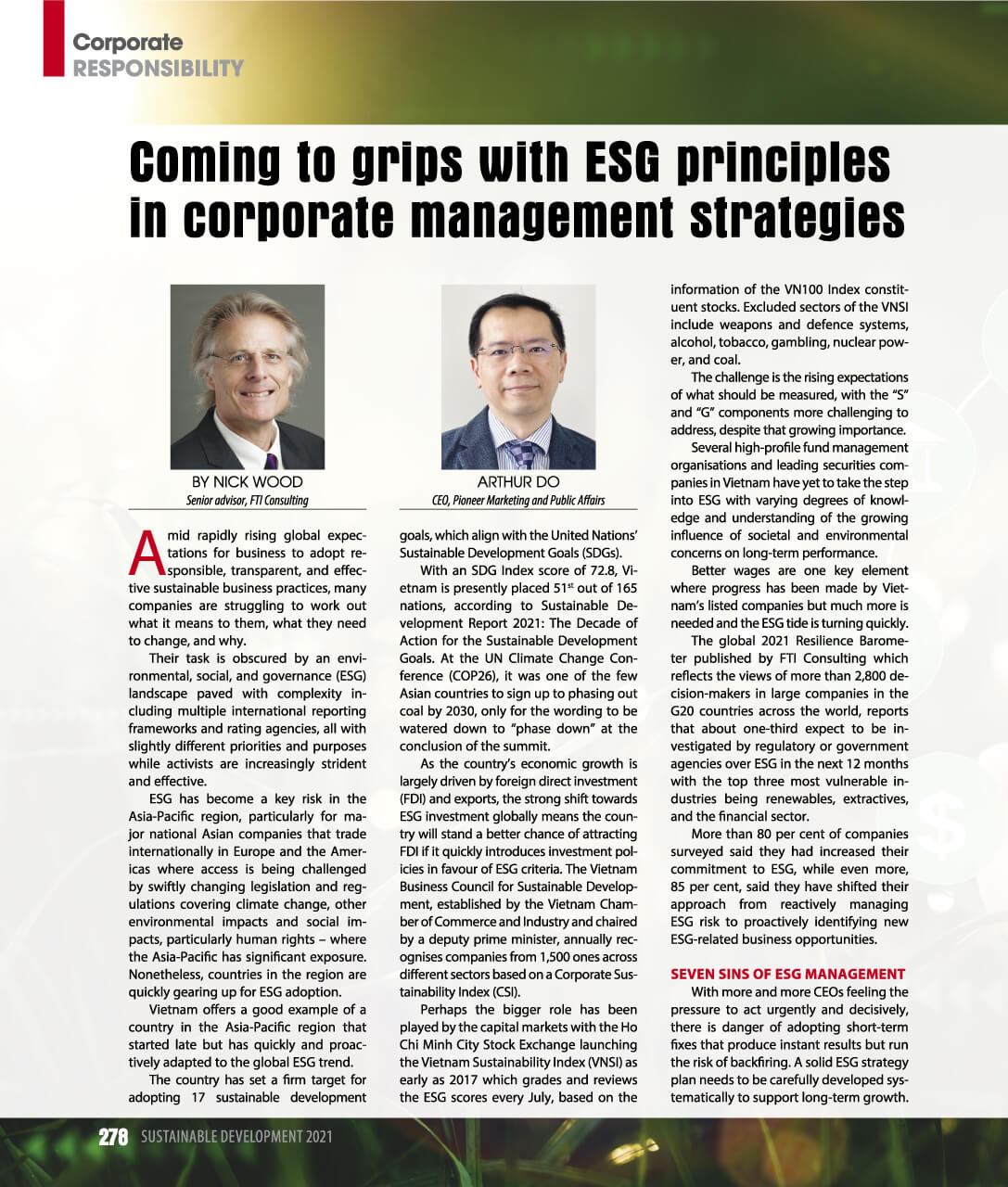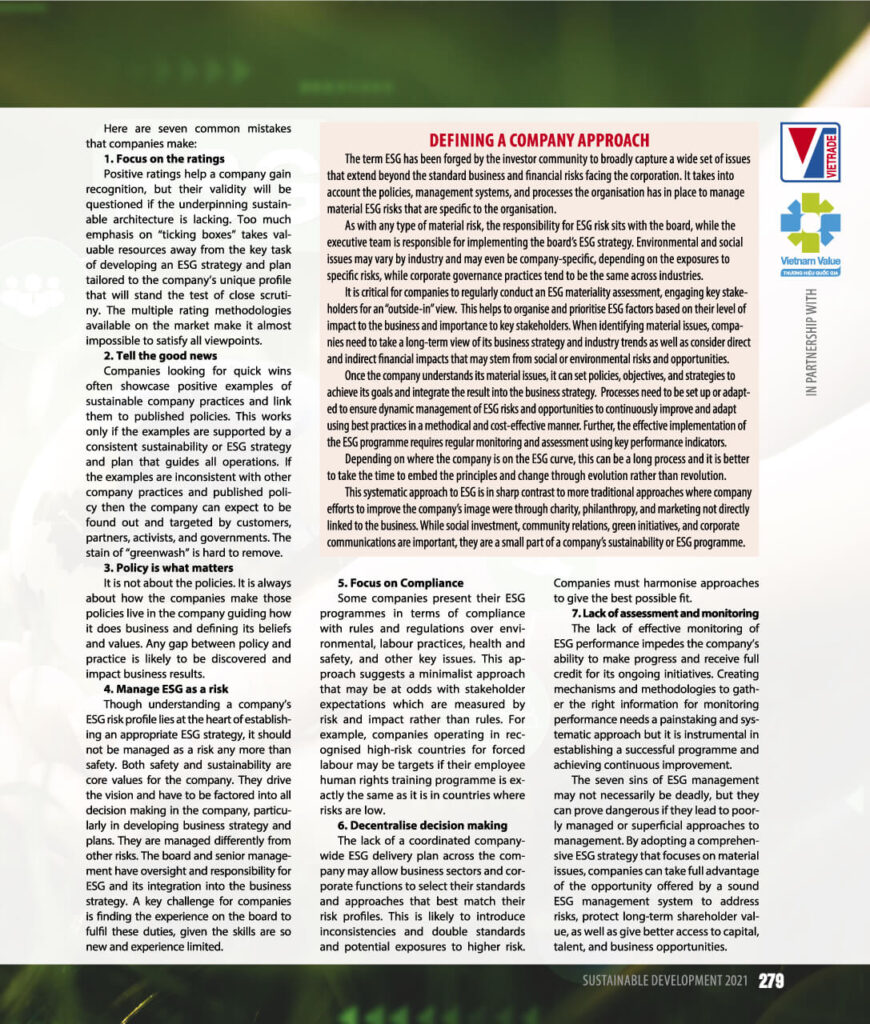By Nick Wood, senior advisor, FTI Consulting
And
Arthur Do, CEO, Pioneer Marketing & Public Affairs

Arthur Do 
Nick Wood
Amid rapidly rising global expectations for business to adopt responsible, transparent, and effective sustainable business practices, many companies are struggling to work out what it means to them, what they need to change, and why.
Their task is obscured by an environment, social, and governance (ESG) landscape paved with complexity including multiple international reporting frameworks and rating agencies, all with slightly different priorities and purposes while activists are increasingly strident and effective.
ESG has become a key risk in the Asia-Pacific region, particularly for major national Asian companies that trade internationally in Europe and the Americas where access is being challenged by swiftly changing legislation and regulations covering climate change, other environmental impacts and social impacts, particularly human rights – where the Asia-Pacific has significant exposure. Nonetheless, countries in the region are quickly gearing up for ESG adoption.
Vietnam offers a good example of a country in the Asia-Pacific region that started late but has quickly and proactively adapted to the global ESG trend.
The country has set a firm target for adopting 17 sustainable development goals, which align with the United Nation’s Sustainable Development Goals (SDGs).
With an SDG Index score of 72.8, Vietnam is presently placed 51st out of 165 nations, according to Sustainable Development Report 2021: The Decade of Action for the Sustainable Development Goals. At COP26 it was one of a few Asian countries to sign up to phasing out coal by 2030, only for the wording to be watered down to ‘phase down’ at the conclusion of the summit.
As the country’s economic growth is largely driven by foreign direct investment (FDI) and exports, the strong shift towards ESG investment globally means the country will stand a better chance of attracting FDI if it quickly introduces investment policies in favour of ESG criteria. The Vietnam Business Council for Sustainable Development, established by the Vietnam Chamber of Commerce and Industry and chaired by a deputy prime minister, annually recognises companies from 1,500 ones across different sectors based on a Corporate Sustainability Index (CSI).
Perhaps the bigger role has been played by the capital markets with the Ho Chi Minh City Stock Exchange (HSX) launching the Vietnam Sustainability Index (VNSI) as early as 2017 which grades and reviews the ESG scores every July, based on the information of the VN100 Index constituent stocks. Excluded sectors of the VNSI include weapons and defence systems, alcohol, tobacco, gambling, nuclear power, and coal.
The challenge is the rising expectations of what should be measured, with the “S” and “G” components more challenging to address, despite that growing importance.
A number of high-profile fund management organisations and leading securities companies in Vietnam are yet to take the step into ESG with varying degrees of knowledge and understanding of the growing influence of societal and environmental concerns on long-term performance.
Better wages are one key element where progress has been made by Vietnam’s listed companies but much more is needed and the ESG tide is turning quickly.
The global 2021 Resilience Barometer published by FTI Consulting which reflects the views of more than 2,800 decision makers in large companies in the G20 countries across the world, reports that about one-third expect to be investigated by regulatory or government agencies over ESG in the next 12 months with the top three most vulnerable industries being renewables, extractives, and the financial sector.
More than 80 per cent of companies surveyed said they had increased their commitment to ESG, while even more, 85 per cent, said they have shifted their approach from reactively managing ESG risk to proactively identifying new ESG-related business opportunities.
The 7 sins of ESG management
With more and more CEOs feeling the pressure to act urgently and decisively, there is danger of adopting short term fixes that produce instant results but run the risk of backfiring. A solid ESG strategy plan needs to be carefully developed systematically to support long-term growth.
Here are seven common mistakes that companies make:
Focus on the ratings
Positive ratings help a company gain recognition, but their validity will be questioned if the underpinning sustainable architecture is lacking. Too much emphasis on “ticking boxes” takes valuable resources away from the key task of developing an ESG strategy and plan tailored to the company’s unique profile that will stand the test of close scrutiny. The multiple rating methodologies available on the market make it almost impossible to satisfy all viewpoints.
Tell the good news
Companies looking for quick wins often showcase positive examples of sustainable company practices and link them to published policies. This works only if the examples are supported by a consistent sustainability or ESG strategy and plan that guides all operations. If the examples are inconsistent with other company practices and published policy then the company can expect to be found out and targeted by customers, partners, activists and governments. The stain of ‘greenwash’ is hard to remove.
Policy is what matters
It’s not about the policies. It is always about how the companies make those policies live in the company guiding how it does business and defining its beliefs and values. Any gap between policy and practice is likely to be discovered and impact business results.
Manage ESG as a risk
Though understanding a company’s ESG risk profile lies at the heart of establishing an appropriate ESG strategy, it should not be managed as a risk any more than safety. Both safety and sustainability are core values for the company. They drive the vision and have to be factored into all decision making in the company, particularly in developing business strategy and plans. They are managed differently to other risks. The board and senior management have oversight and responsibility for ESG and its integration into the business strategy. A key challenge for companies is finding the experience on the board to fulfill these duties given the skills are so new and experience limited.
Focus on Compliance
Some companies present their ESG programs in terms of compliance with rules and regulations over environmental, labour practices, health and safety, and other key issues. This approach suggests a minimalist approach that may be at odds with stakeholder expectations which are measured by risk and impact rather than rules. For example, companies operating in recognised high risk countries for forced labour may be targets if its employee human rights training program is exactly the same as it is in countries where risks are low.
Decentralise decision making
The lack of a coordinated companywide ESG delivery plan across the company may give business sectors and corporate functions opportunity to select their own standards and approaches that best match their risk profiles. This is likely to introduce inconsistencies and double standards and potential exposures to higher risk. Companies must harmonize approaches to give the best possible fit.
Lack of assessment and monitoring
The lack of effective monitoring of ESG performance impedes the company’s ability to make progress and receive full credit for its ongoing initiatives.
Creating mechanisms and methodologies to gather the right information for monitoring performance needs a painstaking and systematic approach but it is instrumental in establishing a successful program and achieving continuous improvement.
The seven sins of ESG management may not necessarily be deadly, but they can prove dangerous if they lead to poorly managed or superficial approaches to management. By adopting a comprehensive ESG strategy that focuses on material issues, companies can take full advantage of the opportunity offered by a sound ESG management system to address risks, protect long-term shareholder value, as well as give better access to capital, talent, and business opportunities.
https://vir.com.vn/coming-to-grips-with-esg-principles-in-corporate-management-strategies-89725.html





